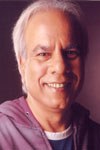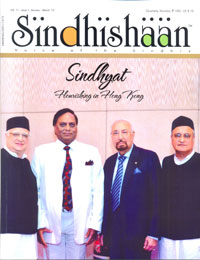THE CHANGING FACE OF SINDHI PSYCHIC
by - Arun Babani

Human mind is one – universal. But there are many shades to it. Every community in India and abroad tends to form its own unique identity and psychological tendencies. These tendencies are based on a few fundamentals like the history, economic status, style and nature of work, emotional make-up and so on. Sindhis of the post partition era have certain common psychic traits which we will try to enumerate and understand here.
In Sindh, Sindhis were known to be peace loving, happy-go-lucky and a religious lot. Then suddenly due to the partition about ten lakh Sindhis traveled in sub-human conditions to India and other parts of the world. This has come to be known as the 'Partition Trauma.' From 50s to the 80s – thirty years, the community struggled and underwent humiliation to get themselves a decent roof and lead an honorable life. For those 30 years, most of the Sindhi men, women and children, who were semi-literate, worked hard and survived, prospered and resettled.
 It is this crucial period of struggle that gave the Sindhi a new self identity. In just 30 years, from being known as Sindhi refugee he came to called a Sindhi Seth. The hard earned money made him a king of his clan. Neighbor's envy spread soon and jokes were created. 'Sindhi ka bachcha kabhi nahin sacha'. Since he was a semi-literate but rich, he acquired all the good stuff of life, including loud interiors and shiny cars. That again brought in fresh demeaning labels and he began to be seen as wheeler-dealer, agent-vegent.
It is this crucial period of struggle that gave the Sindhi a new self identity. In just 30 years, from being known as Sindhi refugee he came to called a Sindhi Seth. The hard earned money made him a king of his clan. Neighbor's envy spread soon and jokes were created. 'Sindhi ka bachcha kabhi nahin sacha'. Since he was a semi-literate but rich, he acquired all the good stuff of life, including loud interiors and shiny cars. That again brought in fresh demeaning labels and he began to be seen as wheeler-dealer, agent-vegent.
The first thing that strikes about the partition is that his education suffered. Very few Sindhis of those times got themselves educated, culturally or technologically. The prosperity is solely the result of great struggle and hard work. Adapting to the environment is known to be the greatest quality of Sindhis. The Late Gobind Malhi, who traveled to all corners of India and the world, meeting thousands of Sindhis in his travels, concluded that a Sindhi bhau can live and prosper anywhere and in any condition.
This prosperity has brought in its wake a few weaknesses too. Many people believe that Sindhis are a worried lot. They worry about every little detail of life. This trait can be understood in a larger perspective that the resettlement is a concept that almost stands on the foundation of care, concern and calculation which can soon cross over to worry. Worrying is a general human tendency and is found in the poor as well as rich countries. It stems from insecurity and instability. Women tend to be greater victims of worry than men and visit Sadhus and Babas to get rid of it.
As usually believed, a normal average Sindhi is not arrogant and egoistic. Rather he is known to be humble and kind. Sindhis have been influenced by three major religions – Hinduism, Sufism and Sikhism. So they have imbibed very humble attitudes and by and large are a peaceful and contented lot.
Some people are of the impression that Sindhis are miserly and kanjoos. Well, there are many misers in the community but there are many large-hearted Sindhis too. However, as the general impression suggests Sindhis do come out as misers and it is perhaps because a lot of hard work and struggle has gone into making their riches and they seem to use it prudently.
Lastly, Sindhis are seen to be greedy people. Well, it is the times of greed, everybody seems to be greedy and so is our Sindhi bhau. It is said that Much wants More and Sindhis having much now seem to want more. By and large it seems to be a human tendency to have more and more and Sindhis too won't stop easily or give up quickly.
The young generation of Sindhis, born after 80s however seem to be a little advanced and progressive. This is perhaps due to the absence of a strict religious upbringing, coupled with modern scientific education and the hard earned prosperous background which makes the young Sindhi appear to be better equipped to deal with life, more polished and graceful in his lifestyle. In this ongoing process of modernization the young Sindhi doesn't resemble and behave like the normal average Sindhi of the old days. Naturally. So with this new generation, the Sindhi identity seems to be taking a newer and better direction while becoming truly global and expansive. The fact that these youngsters have missed out on pure Sindhi culture and tradition and their roots, is a cruel fact of history that cannot be reversed. But there is also the irrefutable fact of modern history that most of the old-world cultures are slowly disappearing everywhere. All the same, the insecurities and worries of their parents seem not to bother these youngsters and they look carefree and happy. From a refugee to global a Sindhi bhau has travelled a long way. The worries of the previous generation have borne fruit and transformed into the confidence of this generation.
The partition trauma is a distant memory. The global recognition is the future possibility. There is no looking back now.


